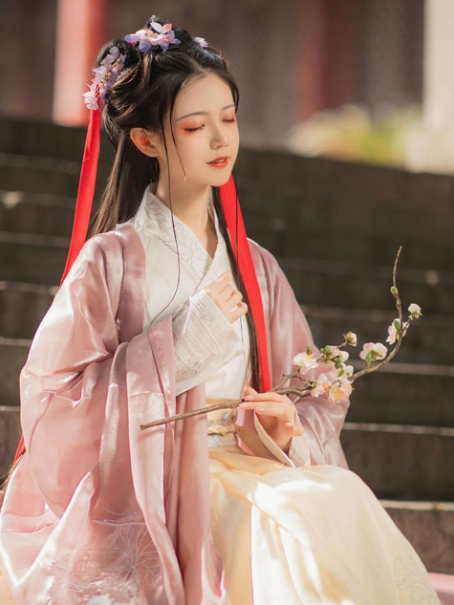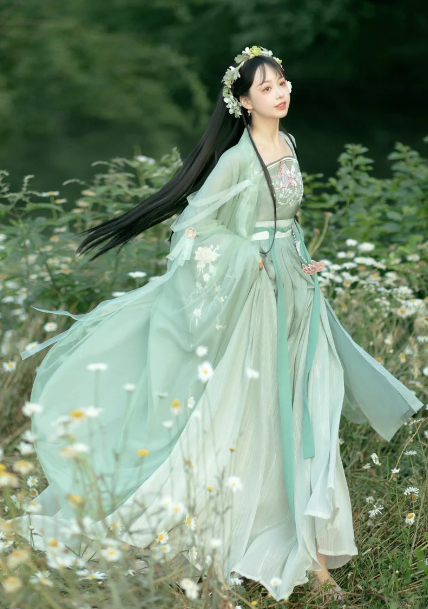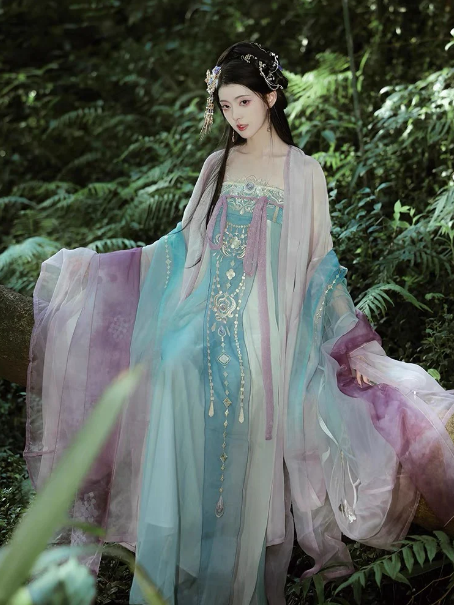Introduction: The Essence of Hanfu
Hanfu, the traditional attire of the Han Chinese people, exemplifies the depth and richness of Chinese culture. Historically, it represents more than just clothing; it embodies the aesthetic spirit, ethical codes, and social norms of ancient China.
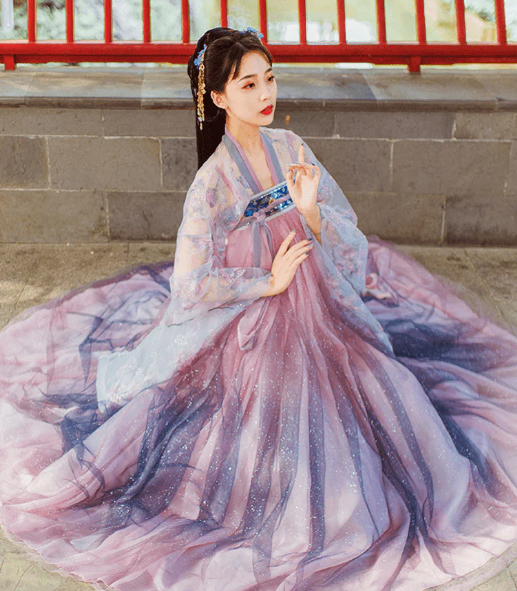
The Origin and Evolution
The term “Hanfu” literally translates to the “clothing of the Han people.” Its origin traces back over 3000 years to the dynasties of Huang Di and Yan Di. Initially, Hanfu served as a marker of cultural identity, distinguishing the Han people from other ethnic groups in China. Over centuries, its styles evolved, deeply influenced by the social and political changes across various dynasties such as the Tang, Song, and Ming. Each era added unique elements to Hanfu, reflecting the prevailing ideologies and aesthetic preferences.
Design and Symbolism
Hanfu’s design is not merely about visual appeal but also symbolic meanings. The traditional Hanfu, often featured in Tang Dynasty paintings, consists of several key components: the Yi (a narrow-cuffed, knee-length tunic tied with a sash), the Chang (an ankle-length skirt), and the Pao (a long-sleeved robe). Each element, from sleeve length to garment color, held significance. For example, colors in Hanfu often symbolized social status and philosophical ideals. Yellow, often worn by emperors, represented the center of the universe and the Earth in ancient Chinese cosmology.
Cultural Significance
Throughout Chinese history, Hanfu has been more than just attire; it’s a carrier of etiquette and a symbol of civilization. The Confucian ideals of propriety (‘Li’) were intricately woven into the fabric of Hanfu, influencing its design and the manner of wearing it. This attire promoted a dignified and upright posture, believed to encourage moral conduct. Furthermore, the resurgence of Hanfu in modern times not only reflects a growing interest in traditional culture among China’s youth but also a desire to reconnect with their heritage in an increasingly globalized world.
By understanding Hanfu’s historical evolution, design intricacies, and cultural significance, we can appreciate why this traditional attire remains a beautiful and enduring symbol of Chinese culture.
The Elegance of Design
The design of Hanfu is a testament to the intricate craftsmanship and artistic sensibilities that have been passed down through generations. From the style to the fabric and color choices, every aspect of Hanfu is carefully considered to create a garment that exudes elegance and cultural significance.
Style Variations
Hanfu boasts a wide range of styles, each with its own unique charm and historical relevance. Styles such as the “Ruqun” consist of a top and a skirt, while more elaborate styles like the “Xiapei” incorporate layered robes. These designs are not only visually striking but also serve functional purposes. The layered robes, for example, provided warmth during cold winters while maintaining an elegant appearance.
Fabric Selection
The choice of fabric in Hanfu design is crucial in achieving both aesthetics and comfort. Traditional Hanfu was often crafted from high-quality silk, a material known for its softness and luxurious sheen. Silk not only added to the visual appeal but also ensured the wearer’s comfort. The use of silk also reflects the historical value placed on quality materials in Chinese culture.
Color Symbolism
Colors in Hanfu are not chosen randomly; they carry deep cultural and symbolic meanings. Red, for instance, symbolizes happiness and good fortune and is often worn during celebrations and weddings. Blue and green represent harmony with nature, while yellow has been reserved for emperors, symbolizing the supreme authority. These color choices not only enhance the beauty of Hanfu but also convey rich cultural messages.
Incorporation of Intricate Details
Hanfu designers pay meticulous attention to details. Embroidery, intricate patterns, and decorative elements like buttons and sashes are used to enhance the overall design. These details can vary significantly depending on the wearer’s social status and the occasion. For instance, formal Hanfu may feature elaborate embroidery, while everyday attire may be simpler in design.
Contemporary Adaptations
In recent years, designers have been innovating with Hanfu styles to make them more adaptable to modern lifestyles. While traditional materials like silk remain popular, contemporary Hanfu designs may also incorporate more affordable fabrics like cotton or synthetic blends to make them accessible to a wider audience. This adaptation balances the desire to preserve cultural heritage with practical considerations of cost and availability.
By carefully considering style, fabric, color symbolism, and intricate details, Hanfu design achieves a remarkable balance of elegance, cultural significance, and functionality. These elements come together to create a truly beautiful and meaningful form of traditional attire.
Symbolism and Cultural Depth
Hanfu clothing is not just a fashion statement; it is a deep reflection of Chinese culture and history. Every element of Hanfu carries profound symbolism and cultural significance, creating a rich tapestry of meaning and tradition.
Embodying Chinese Values
Confucian Influence
- The design of Hanfu is influenced by Confucian values, emphasizing propriety, respect, and adherence to social norms.
Harmony with Nature
- The use of natural colors and patterns in Hanfu reflects the Chinese belief in harmony with the environment and the cyclical nature of life.
Symbolic Elements in Hanfu
Dragons and Phoenixes
- The presence of dragon and phoenix motifs symbolizes auspiciousness, with the dragon representing the emperor and the phoenix symbolizing the empress.
Five Elements
- Hanfu often incorporates the five elements (wood, fire, earth, metal, water) into its design, representing balance and harmony.
Yin and Yang
- The dualism of yin and yang is represented through contrasting colors and elements, signifying the balance of opposites in the universe.
Cultural Depth in Hanfu
Historical References
- Hanfu’s designs often draw inspiration from various dynastic periods, paying homage to China’s rich history.
Regional Variation
- Different regions in China have their own unique styles of Hanfu, reflecting local customs and traditions.
Ritual and Ceremonial Use
- Hanfu is worn during important ceremonies such as weddings, coming-of-age ceremonies, and ancestral rites, highlighting its cultural significance.
Modern Revival
- The revival of Hanfu in recent years is seen as a cultural reawakening and an effort to reconnect with China’s historical roots.
In summary, Hanfu’s beauty goes beyond aesthetics; it is deeply rooted in Chinese culture and history. The intricate symbolism and cultural depth woven into every garment make Hanfu a symbol of national pride and a testament to the enduring legacy of Chinese civilization. Understanding these cultural aspects adds a layer of appreciation for the beauty and significance of Hanfu attire.
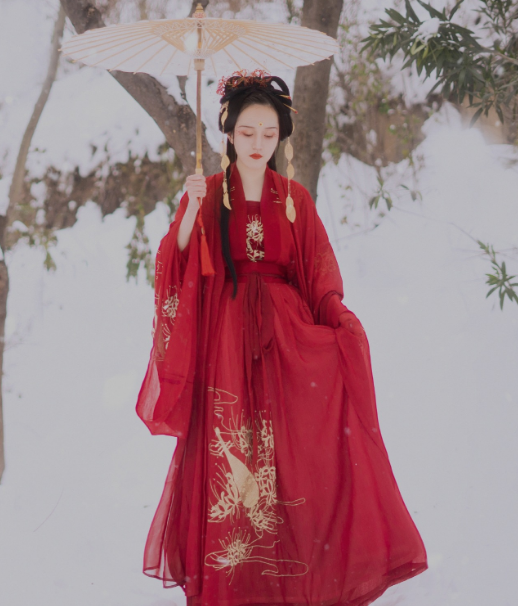
Craftsmanship and Artistry
The creation of Hanfu is a testament to the exceptional craftsmanship and artistry that has been passed down through generations. Each piece of Hanfu is a work of art, painstakingly crafted with attention to detail and a deep understanding of traditional techniques.
Traditional Techniques Preserved
Hand Embroidery
- Hand embroidery is a hallmark of Hanfu craftsmanship, with intricate designs meticulously stitched by skilled artisans. This technique requires exceptional dexterity and can take weeks or even months to complete.
Silk Weaving
- Hanfu is often made from silk, a luxurious and durable material. Silk weaving involves the careful interlacing of threads to create intricate patterns and textures.
Dyeing Methods
- Traditional dyeing methods such as tie-dye and batik are used to create unique and vibrant colors on Hanfu fabrics. Natural dyes from plants and minerals are still employed to achieve authentic hues.
Fabric Selection
- Choosing the right fabric is crucial in Hanfu creation. Fabrics like silk and brocade are preferred for their quality and authenticity.
Modern Adaptations and Innovations
Technology Integration
- Modern technology has been integrated into Hanfu production to enhance efficiency without compromising quality. Computer-aided design (CAD) helps create precise patterns, reducing the margin of error.
Quality Control
- Strict quality control measures are in place to ensure that each Hanfu garment meets the highest standards. This includes testing for color fastness, fabric strength, and durability.
Cost Considerations
- While traditional craftsmanship remains integral, efforts are made to balance cost considerations. Efficiency improvements have helped manage production costs without compromising on quality.
Customization
- Some artisans offer customization options, allowing customers to choose specific fabrics, colors, and designs to create a personalized Hanfu garment.
Preservation of Techniques
- Organizations and workshops dedicated to preserving traditional Hanfu craftsmanship ensure that these skills continue to be passed down to new generations.
In conclusion, Hanfu’s craftsmanship and artistry are a testament to the dedication of skilled artisans who continue to uphold centuries-old traditions. The fusion of traditional techniques with modern innovations allows Hanfu to remain a symbol of cultural heritage while adapting to the demands of the contemporary world. Each Hanfu garment represents a blend of history, culture, and artistry, making it a truly remarkable piece of clothing.
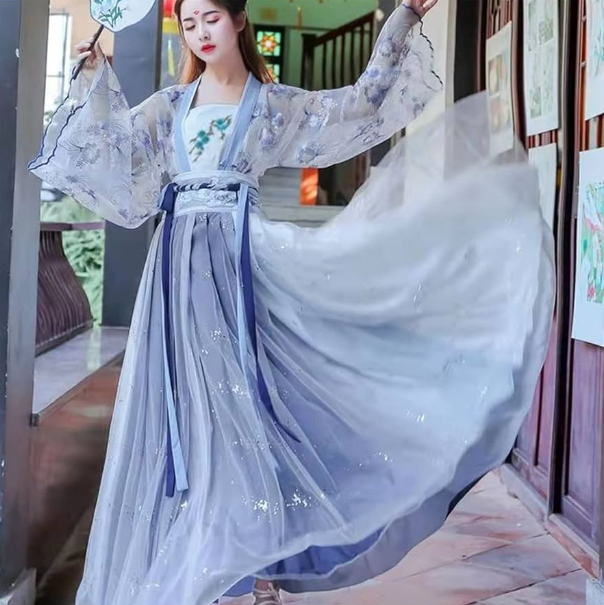
Hanfu’s Influence and Revival
The revival of Hanfu in recent years has had a profound impact on both the fashion industry and the cultural identity of individuals. This resurgence represents a significant shift in societal attitudes towards traditional Chinese clothing.
Fashion Renaissance
Reinterpretation of Tradition
- Contemporary designers have reinterpreted Hanfu, blending traditional elements with modern aesthetics to create a fresh and fashionable look.
Global Recognition
- Hanfu’s growing popularity on international runways and in fashion magazines has introduced Chinese traditional clothing to a global audience.
Influence on Contemporary Fashion
- Hanfu-inspired designs have influenced modern fashion trends, leading to the incorporation of Hanfu elements into everyday wear.
Inclusivity and Diversity
- Hanfu’s revival promotes cultural diversity and inclusivity, encouraging people from various backgrounds to embrace and celebrate Chinese culture.
Cultural Identity
Reconnecting with Heritage
- The revival of Hanfu has allowed many Chinese individuals to reconnect with their cultural heritage, fostering a sense of pride and identity.
Cultural Preservation
- The renewed interest in Hanfu has led to the preservation and documentation of traditional clothing-making techniques and historical knowledge.
Community and Social Movements
- Hanfu enthusiasts often participate in community events, festivals, and social gatherings, strengthening their sense of belonging to a larger cultural community.
Educational Impact
- Educational institutions have begun offering courses on Hanfu design and history, further promoting cultural awareness and appreciation.
Impact on the Economy
Economic Growth
- The Hanfu industry has contributed to economic growth through the sale of clothing, accessories, and related products.
Job Creation
- The revival of Hanfu has created employment opportunities for artisans, tailors, and designers, supporting local economies.
Market Expansion
- The Hanfu market has expanded both domestically and internationally, with businesses catering to a diverse customer base.
Investment in Production
- Investment in Hanfu production has led to improved quality, production efficiency, and cost management.
In summary, Hanfu’s influence and revival extend beyond the realm of fashion, encompassing cultural identity, economic impact, and global recognition. This resurgence not only brings traditional Chinese clothing to the forefront of contemporary fashion but also fosters a sense of pride and cultural preservation among individuals and communities. The ongoing revival of Hanfu continues to shape the way people perceive and engage with Chinese culture.
Conclusion: The Timeless Appeal of Hanfu
As we conclude our exploration of Hanfu, it becomes evident that its timeless appeal transcends mere fashion trends. Hanfu’s enduring charm lies in its deep cultural roots, exquisite craftsmanship, and its ability to evolve with the times while preserving its heritage.
Cultural Legacy and Continuity
Preserving Cultural Legacy
- Hanfu’s revival ensures the preservation of China’s rich cultural legacy, passing down traditions, values, and historical knowledge to future generations.
Cultural Continuity
- The continued adoption and adaptation of Hanfu in modern contexts ensure its relevance and continuity in contemporary Chinese culture.
Cross-Generational Connection
- Hanfu bridges the generation gap, fostering a connection between older generations who may have worn traditional clothing and younger generations embracing their cultural roots.
Future Perspectives
Global Influence
- Hanfu’s influence is expected to expand globally, with more people worldwide appreciating and adopting elements of Chinese traditional clothing.
Fashion Innovation
- Ongoing innovation in Hanfu design and production techniques will likely keep it at the forefront of fashion trends while preserving its authenticity.
Education and Awareness
- Educational initiatives and cultural events will continue to raise awareness and deepen understanding of Hanfu, promoting cultural appreciation.
Economic Growth
- The Hanfu industry is poised for further economic growth, creating jobs and opportunities while contributing to China’s cultural and creative economy.
The Timeless Beauty of Hanfu
Eternal Appeal
- Hanfu’s timeless beauty, characterized by its elegance, symbolism, and cultural depth, ensures its continued allure for generations to come.
Adaptive Resilience
- Hanfu’s ability to adapt to changing times while maintaining its core essence demonstrates its resilience as a cultural phenomenon.
Cultural Fusion
- The fusion of traditional and modern elements in Hanfu design allows it to resonate with a diverse and global audience.
In essence, Hanfu represents more than just clothing; it is a living testament to China’s rich cultural heritage and its ability to transcend time and borders. As Hanfu’s influence and revival continue to shape the cultural landscape, it remains a symbol of pride, identity, and artistic expression that will endure for centuries to come.
